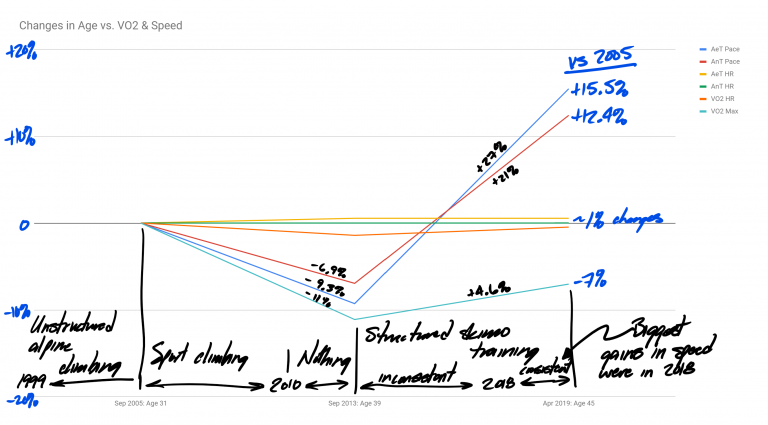Max VO2 is often considered the holy grail of endurance qualities, a belief that dominates the fitness landscape. With its focus in popular training methodologies, VO2 max is frequently seen as the metric that rules them all. Articles and programs everywhere tout boosting your VO2 max as the secret to peak athletic performance. But of the three main components of endurance—economy, speed at lactate threshold (also known as anaerobic threshold), and VO2 max—this metric actually correlates the least with real performance. It’s time to debunk the VO2 max myth.
What Exactly is VO2 Max?
VO2 max is the maximum amount of oxygen your body can use during intense exercise. It’s measured in milliliters of oxygen used per kilogram of body weight per minute (ml/kg/min). Discovered in the 1920s by A.V. Hill, VO2 max provided one of the first scientific explanations for the limits of human performance. Hill’s discovery remains a key component in exercise science today, but is it the ultimate predictor of success?
The Components of Endurance: Why VO2 Max Isn’t Everything
When it comes to endurance, three main factors affect performance:
- VO2 Max – the maximum oxygen uptake.
- Lactate Threshold (Anaerobic Threshold) – the speed or effort level at which lactate starts to accumulate in the blood.
- Economy – how efficiently your body uses energy at a given speed.
While VO2 max is often the focal point, research shows it actually correlates the least with endurance performance, especially for well-trained athletes. The other two factors—economy and lactate threshold—often play a more significant role in determining how well you perform.
A Real-World Example: Why VO2 Max Isn’t the Only Predictor
During my ski racing career, I was tested repeatedly for VO2 max, consistently scoring higher than many of my competitors. Yet, they consistently outperformed me in races. This discrepancy led me to question the assumption that VO2 max alone predicts success. Over time, I realized the missing link was economy—a concept that wasn’t even considered 35 years ago. The efficiency with which I expended energy at racing speed held me back more than my VO2 max, as I used more energy than necessary to maintain the same speed.
The Plateau of VO2 Max: Genetics, Physiology, and Limitations
For most trained athletes, VO2 max can be improved with high-intensity interval training (HIIT) at or above 90% of maximum heart rate. This type of training increases the heart’s stroke volume, allowing more oxygen-rich blood to reach muscles. However, the heart’s growth is limited by the pericardium, an inelastic sheath that surrounds it. Once the heart reaches its maximum capacity, VO2 max plateaus, and further improvements become difficult to achieve.
What this graphic demonstrates so clearly is that Scott’s max VO2 (the turquoise line at the bottom) declined 11 percent between the age of 31 and 39 and remains 7 percent below his age 31 peak. Since beginning structured skimo training, his max VO2 has risen only 4 percent but his performance (as indicated by his paces, the red and blue lines) has improved dramatically. Something other than the small change in max VO2 must have played a role in his improvement in performance.
Implications for Endurance Athletes
If you’re an experienced athlete with a solid history of HIIT, chances are your VO2 max is already near its genetic limit. Rather than obsessing over a slight increase in VO2 max, you may find more benefit in focusing on factors like economy and lactate threshold, which may have more room for improvement.
The Real Meaning of a High VO2 Max
A high VO2 max is beneficial, but it doesn’t guarantee superior performance. VO2 max represents the upper limit of your aerobic power—like a car’s horsepower. However, just as a car with poor fuel economy burns through gas faster, a runner or skier with poor movement economy will use more oxygen to sustain the same speed.
Having a high VO2 max doesn’t necessarily mean you’ll perform better; it’s more useful as a rough benchmark of your aerobic potential than as a predictor of race outcomes.
Why VO2 Max Became the Go-To Metric in Endurance Training
Exercise studies often measure VO2 max to determine the effectiveness of training protocols. It’s easy to measure, compare, and analyze, making it a convenient research metric. But using VO2 max as the primary measure of success is misleading. Most studies use untrained subjects, whose VO2 max improves quickly regardless of the training type. However, VO2 max gains typically plateau after four to six months, especially for trained athletes, while other indicators of endurance can continue to improve with targeted training.
What Should You Focus On Instead?
If you’re a trained athlete looking to enhance your performance, consider placing more emphasis on:
Economy – Improving technique and efficiency helps you use less energy at the same pace. Focus on optimizing form, biomechanics, and strength in your sport-specific muscles.
Lactate Threshold – Work on increasing the pace at which your body can sustain lactate clearance, allowing you to perform at higher intensities without fatigue.
A Case in Point: Shifting the Focus Beyond VO2 Max
I once trained an athlete who had spent years working solely to improve his VO2 max, yet his race results stagnated. At 30, he came to me for training, and I advised him to stop focusing on his VO2 max. Instead, we worked on his economy, which improved his efficiency and allowed him to race faster without requiring a massive aerobic engine. The following season, he was the fastest skier in the country.
Conclusion: Breaking the VO2 Max Myth
While VO2 max can offer valuable insights, it’s not the definitive measure of endurance performance. For trained athletes, VO2 max often plateaus, and further improvements require focusing on other areas of endurance, like economy and lactate threshold. In the complex world of endurance, VO2 max is simply one tool among many, and elevating it above other key factors can hinder more holistic development.
For those looking to improve endurance performance, the best approach is a balanced training plan that enhances efficiency, increases lactate threshold, and—if there’s still room for growth—maintains VO2 max. This balanced focus can unlock more sustainable, long-term gains and help athletes truly reach their potential.
References and further reading
Coyle, EF. “Increased muscular efficiency displayed as Tour de France champion matures.” Journal of Applied Physiology 2005 Jun;98(6):2191–6.


